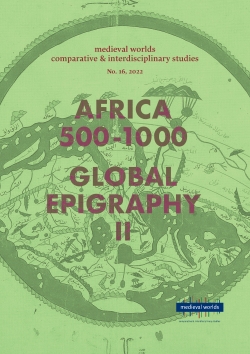Elizabeth Fentress
S. 67 - 92
doi:
10.1553/medievalworlds_no16_2022s67
Verlag der Österreichischen Akademie der Wissenschaften
doi:
10.1553/medievalworlds_no16_2022s67
Abstract:
The article focuses on the “Islamization” of Berber lifestyles, rather than the effects of the conquest on the Romanized inhabitants of towns in the Africa Proconsularis, the medieval Ifriqiya. The examination follows aspects of material culture as a whole, particularly in the Western Maghreb, where urbanism was far less dense. The evidence comes largely from later texts, although new archaeological work, particularly at Rirha and Volubilis, has begun to flesh out the picture. How did Islamization actually affect the Berbers of the West? While we have little evidence for Algeria, where the excavated Islamic sites are no earlier than the tenth century, the excavations at Rirha and Volubilis – Islamic Walila – provide excellent new data as to the gradual shift in settlement types, diet, and pottery, as well as for the use of coinage. For the tenth century, Sétif and now Igīlīz add evidence for the fait accompli of the fully Islamized towns and villages of the Maghreb. Like Romanization, Islamization came about by emulation, particularly among the élites, and by a slow change to the general habitus, with far different starting points for the Arabic and Berber communities.
Ancient history, classical studies, classical archaeology, archaeology, Trans-Saharan archaeology, Arabization, Islamization
Published Online:
2022/06/30 06:37:26
Object Identifier:
0xc1aa5576 0x003d894d
Rights:All rights reserved.For questions regarding copyright and copies please contact us by email.
medieval worlds provides a forum for comparative, interdisciplinary and transcultural studies of the Middle Ages. Its aim is to overcome disciplinary boundaries, regional limits and national research traditions in Medieval Studies, to open up new spaces for discussion, and to help developing global perspectives. We focus on the period from c. 400 to 1500 CE but do not stick to rigid periodization.
medieval worlds is open to submissions of broadly comparative studies and matters of global interest, whether in single articles, companion papers, smaller clusters, or special issues on a subject of global/comparative history. We particularly invite studies of wide-ranging connectivity or comparison between different world regions.
Apart from research articles, medieval worlds publishes ongoing debates and project and conference reports on comparative medieval research.
Editorial
Ingrid Hartl and Walter Pohl
Africa 500-1000. New Perspectives for historical and archaeological research
Guest editors: Roland Steinacher, Paolo Tedesco and Philipp Margreiter
Africa 500-1000. Introduction
Roland Steinacher and Philipp Margreiter
A New Age of Saint Augustine? Antoine-Adolphe Dupuch, François Bourgade, and the
Christians of North Africa (1838-1858)
Bonnie Effros
A Subaltern’s View of Early Byzantine Africa?: Reading Corippus as History
Andy Merrills
Islamizing Berber Lifestyles
Elizabeth Fentress
The Umayyad Dynasty and the Western Maghreb. A Transregional Perspective
Isabel Toral
Maritime Trade from 3rd/9th-century Ifrīqiya: Insights from Legal Sources
Antonia Bosanquet
Africa’s Transitions to the Middle Ages
Paolo Tedesco
Global Epigraphy II. Perception and Representation of the Foreign
Guest editor: Andreas Rhoby
Introduction
Andreas Rhoby
Identification by Architectural Shape.
Sarcophagi of Indigenous People and Foreigners in Roman Imperial Lycia
Oliver Hülden
Imaginations of Barbarians and Barbarian Lands in the Latin Verse Inscriptions
Peter Kruschwitz
“Foreign(er)”, “Strange(r)” and “Extraordinary”:
xenos and its Meanings in Byzantine (Metrical) Inscriptions
Andreas Rhoby
From Genova to Yangzhou? Funerary Monuments for Europeans
in Yuan China and their Paleographic Analysis
Eva Caramello and Romedio Schmitz-Esser
Alieness in Inscriptions and Alien Inscriptions.
Alterity and Strangeness as Reflected in Pre-Modern Inscriptions from Central Europe
Andreas Zajic
Individual Article
Creolisation and Medieval Latin Europe
Bernard Gowers




 Home
Home Print
Print
 References
References
 Share
Share
